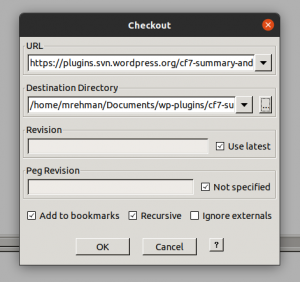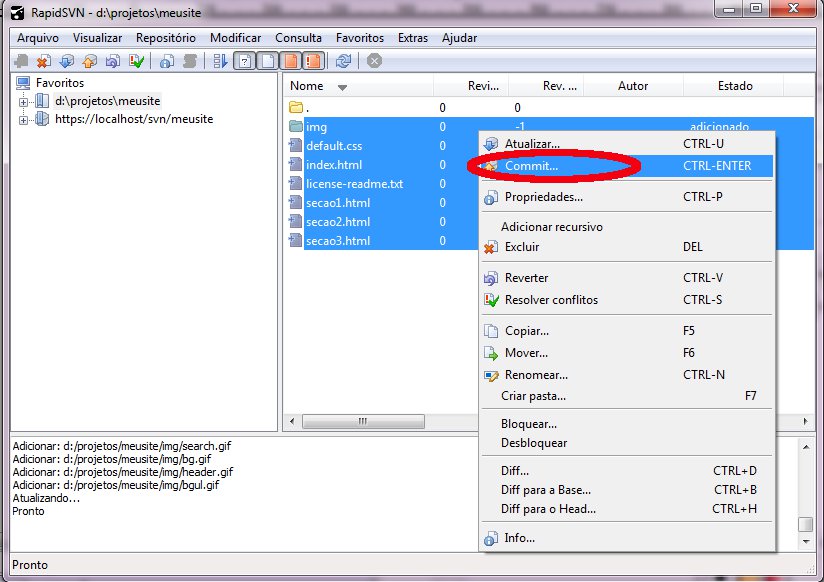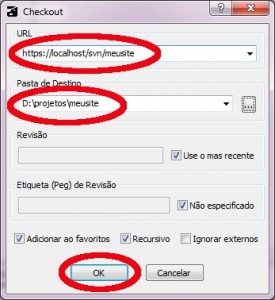
So, as an example, if you have a modified file that you would like to commit, you can select it in the file detail pane and click on the Commit Selected button on the toolbar. If other options are required (such as a revision number), RapidSVN displays a dialog box for you to enter them. To perform a command on a file, you generally just have to select it and then select the command you would like to perform, either from the toolbar or a menu.

For example, modified files are shown with a red file icon (with an M).

RapidSVN shows the status of individual files through both the icon that is used to display the file and a textual representation in the "Status" column. Finally, the bottom pane is used for status output from the running of commands. In the top-right pane, you can see details about each of the files in the directory that is selected in the tree view. The top-left pane shows a tree view of all of the repositories and working copies that you currently have "bookmarked" in RapidSVN. Repositories and working copies are presented in a three-paned interface, as you can see in Figure 8.1. RapidSVN is a full-featured Subversion client interface, with access to most of the Subversion client commands.
#Rapidsvn urls mac os x
RapidSVN will run on a number of other platforms (such as Mac OS X and Solaris), but you may have to compile the program from source code. Compiled binary installations are available as packages for some Linux distributions, and there is an installer for Windows. It can be downloaded from the project's Web site, at. RapidSVN works as a complete standalone client for Subversion, and presents the user with a straightforward, easy-to-use interface, which users of WinCVS will find familiar.
#Rapidsvn urls portable
Although RapidSVN is a natively compiled application (and thus runs with the speed you would expect from a native application), it was written in a very portable manner, which allows it to compile and run on most major platforms. Whatever your platform of choice, the odds are that you can use the RapidSVN GUI client for Subversion. Fortunately, there are a number of GUI clients for Subversion, available for Windows, Mac OS X, and other more traditional UNIX-based systems. With such heavy dependence on a GUI, it only makes sense that it will often be easier to interact with Subversion through the use of a GUI-based tool. Possible local modification, instead of a tree conflict.Most modern desktop or workstation operating systems depend heavily on the use of a graphical user interface (GUI) for interaction with the systemso much so that in many cases, the command line is a dying art. Incoming addition of the same node kind results in a normal node with a If set, a local addition at the same path as an Should unversioned items displayed in commit dialog or not. This cost a depending on tree more or less time. For example, if unversioned items are below which may be added, list items changed and current operation will commit. When doing a commit kdesvn may make a check what to do. This is useful and in most cases it cost not real more traffic. The log command may read list of changed files in commit.
#Rapidsvn urls password
When a password is not stored persistent kdesvn may hold it until kdesvn ends, so you may not need to enter it again for each operation. As long as subversion does not encrypt password storage you should think twice about it.

On other hand other subversion clients aren't able reading them so you must enter them if using tools like svn command line tool or rapidsvn, too. kdesvn is able saving them into encrypted KDE wallet instead there (starting with version 0.12.0) and use them. When saving passwords, the plain text file from subversion is a security hole. This item only says if saving passwords is the default, you may change it for specific realms inside login dialog.

passwords in the plain text! So be careful setting this flag and see next entry, too. Subversion stores its passwords into a flat file, i.e. Storing passwords is often a security problem. When activated, info on folders will gain information about all items below, may be real slow. Be careful: This may let listings REAL slow! When checked, kdesvn get more detailed info about file items when making a listing to remote repositories. Setting this may let listings get real slow. If set kdesvn start (re-)filling the log cache when open a repository or working copy if repository URL is not assigned local ( file://)Ĭheck on working copies if an item has this property set and if yes, displays a special overlayed icon. When open a working copy start a check for updates in background Start check for updates when open a working copy


 0 kommentar(er)
0 kommentar(er)
